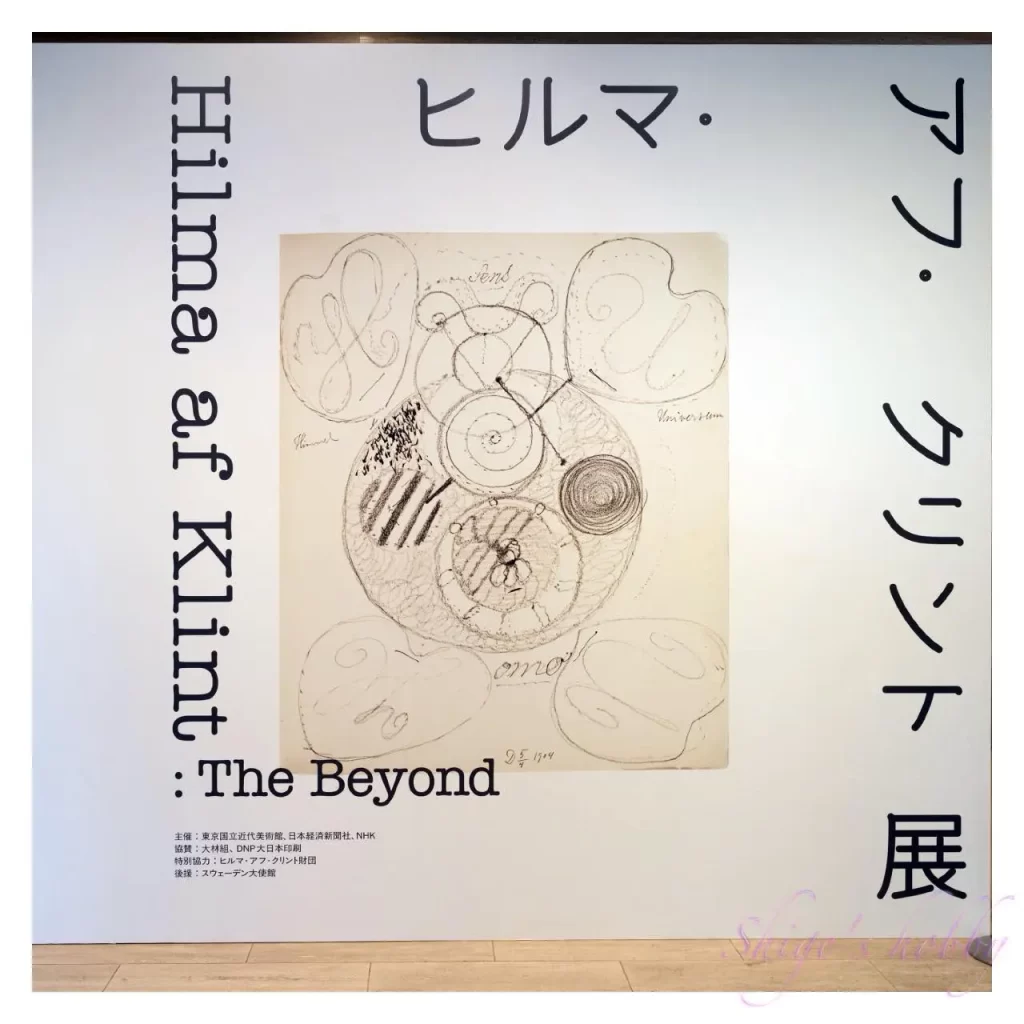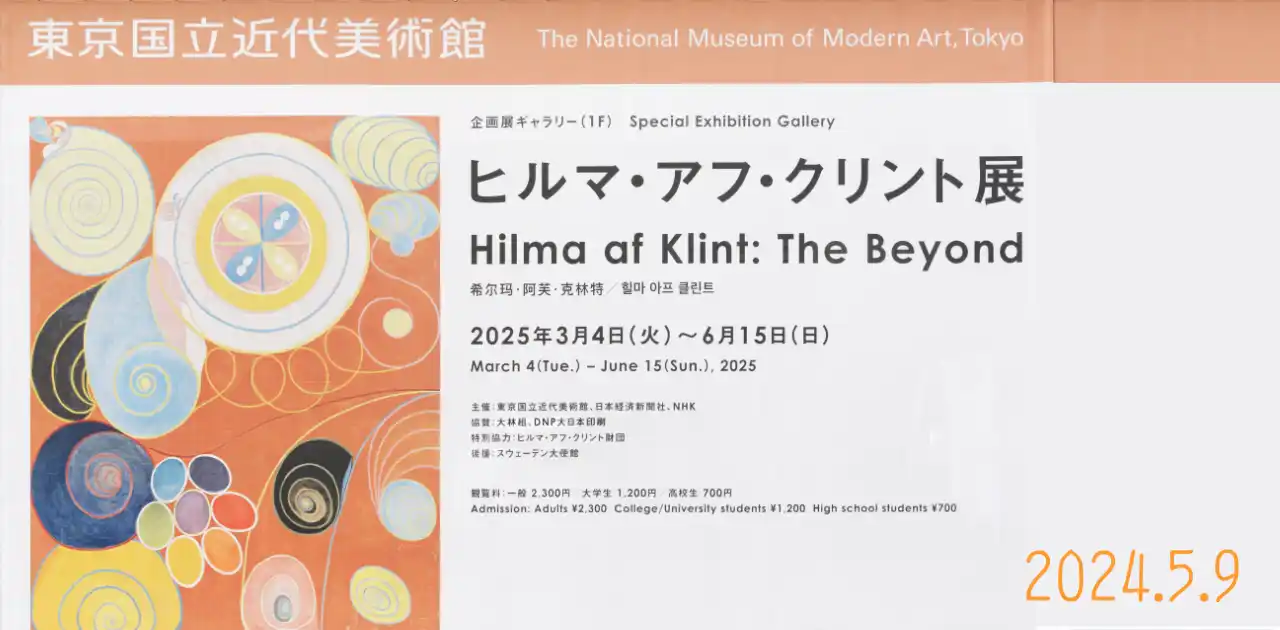Last updated on 2025-08-19
The Beginning of Abstraction?
A review of the “Hilma af Klint Exhibition” held at the National Museum of Modern Art, Tokyo in Kitanomaru Park, Chiyoda Ward, Tokyo.
Table of contents
Hilma af Klint Exhibition, The National Museum of Modern Art, Tokyo
Overview
- Exhibition title: Hilma af Klint Exhibition
- Dates: March 4th – June 15th, 2025
- Location: The National Museum of Modern Art, Tokyo
- Other: Compatible with the Gurutto Pass (100 yen discount on admission with the Gurutto Pass), no touring exhibition.
The exhibition is divided into five chapters, and according to the distribution list, there are 140 works on display plus related materials.
All of the materials are provided by the Hilma af Klint Foundation.
- Chapter 1 ― From an Education at the Academy to a Career as an Artist
- Chapter 2 ― Immersion in the Spiritual World
- Chapter 3 ― The Paintings for the Temple
- Chapter 4 ― After The Paintings for the Temple: A Journey to Anthroposophy
- Chapter 5 ― Toward Perfect Systematization
The exhibition takes up the entire first floor, where the ticket booth is located, and catalogs and other materials are sold at a special shop at the exhibition exit.
Review
I went to see it because I was attracted by the vivid colors painted on the leaf.
I had almost no preconceptions beforehand and even ignored all the exhibition reports in the media, but I thought it was a good experience overall and would recommend anyone who is unsure about seeing it to go without any information. The admission fee is quite expensive, though, so I understand the desire to think about it beforehand.
And now onto my impressions.
The entrance to this exhibition was at the end of the building entrance.
It’s interesting that depending on the exhibition at the Museum of Modern Art, you can enter from the right near the building entrance or go straight ahead.
Chapter 1 ― From an Education at the Academy to a Career as an Artist
This floor is made up of more modest works, which was a little surprising, but it gave the impression that everyone there started their career as an artist, and the rows of sketches and other works look like those of a typical art school student.
And the Museum of Modern Art has not overlooked anything here, as Sketch, Farm with Children [“Maria the Ladybug”] is displayed double-sided so that viewers can see the part on the back that is said to have been drawn by automatic drawing, catching their interest.
When I asked a staff member near the work, he told me this, and that more works like this one would come next.
Chapter 2 ― Immersion in the Spiritual World
Chapter 2 serves as a bridge to Chapter 3, with Seated Woman with a Lily feeling like the artist’s culmination as a professional artist.
Chapter 3 ― The Paintings for the Temple
And in the third chapter, things get interesting as the artist really shows off his talents.
Here, a series of small pieces and medium-sized works are exhibited, and the vivid colors and abstract forms of the leaf paintings appear.
The large room beyond the narrow exhibition hall is the most exciting part of the exhibition, and after viewing the huge “10 Largest Objects,” I was pretty full. For now, I sat on a chair and looked around leisurely.
This time, 2, 3, 2, and 3 works were exhibited on 4 walls, from the left, and the works are said to form a circle, so I felt like I wanted to make a ring with a 10-sided pillar, or to display them in a place where they could be displayed horizontally. It seems that overseas, they are also displayed horizontally.
I wonder if the 10-sided pillar is a cost issue for the exhibition wall? Because of space constraints, one work is about 3m long x 2.5m wide, so if you multiply the width by 10, you will need a space of 25m wide + α. The National Art Center, Tokyo’s Gallery 1E, 2,000 m² (34.2 x 59.5m) seems more than enough to display the works.
- The Ten Largest, Group IV, No. 1, Childhood
- The Ten Largest, Group IV, No. 2, Childhood
- The Ten Largest, Group IV, No. 3, Youth 1907
- The Ten Largest, Group IV, No. 4, Youth 1907
- The Ten Largest, Group IV, No. 5, Adulthood
- The Ten Largest, Group IV, No. 6, Adulthood
- The Ten Largest, Group IV, No. 7, Adulthood
- The Ten Largest, Group IV, No. 8, Adulthood
- The Ten Largest, Group IV, No. 9, Old Age
- The Ten Largest, Group IV, No. 10, Old Age
<The box can be rotated manually. Click to enlarge.>
Then there is a small room displaying five small Trees of Knowledge, ten Swans, and a three-panel Altarpiece, creating a finale-like atmosphere. At the end of Chapter 3 there is a summary panel, so just when you think the exhibition has ended, it continues on to Chapters 4 and 5.
Chapter 4 ― After The Paintings for the Temple: A Journey to Anthroposophy & Chapter 5 ― Toward Perfect Systematization
From chapter 4 to chapter 5, the exhibition continues with a steady display of small pieces, as if wrapping up the show. Compared to the excitement of the large-scale works up to chapter 3, these works are modest, and while they may appeal to connoisseurs, they may leave amateurs feeling a little unsatisfied.
Perhaps this is because the artist became more interested in the spiritual world, or the group’s creative efforts came to a standstill, or perhaps the artist’s creative drive waned with age, but the reasons are unclear, but it seems like we are seeing the artist Klint’s peaceful final years.
It seems that the artist spent his final years compiling his own works, so for him it was a time of retirement.
Finally, a timeline of the artist is displayed, and the exhibition concludes with a display of related books and clippings.
Summary
The exhibition draws a beautiful normal distribution from his early academic period to the establishment of his own style, which peaks and then drops off. This seems to be an ideal depiction of an artist’s life, as the works are exhibited in roughly chronological order.
As for the viewing environment, the large room, which is the highlight of the exhibition, has chairs so you can enjoy the works at your own pace.
The exhibition room for smaller works is tight and a little difficult to see when there are many visitors, but the exhibition is structured so that you can start by looking at the works without anyone in attendance.
Photography is allowed, so if you are bothered by the sound of smartphone or camera shutters, I recommend going later in the day or when there are fewer people.
As I wrote at the beginning, when it is a painter’s first visit to Japan or seeing it for the first time, I try to view it without any preconceptions.
You can enjoy any exhibition without any specialist knowledge, and if you are interested, you should be able to enjoy it even more when you revisit it by gathering information about it.
Gallery
There are plenty of photos of his works on the web, so I won’t post them here.
Art Beat and other sites provide summaries of the artist’s creative work and reviews by professionals, and a biographical film about Clint has also been released, so there is a wealth of information available.

Reference links
- Hilma af Klint: The Beyond・Official page
- [Get to know Hilma af Klint in 10,000 words] Occult painter or pioneer of abstract painting? Interview with Takehito Miwa of the National Museum of Modern Art, Tokyo (Part 1)・Tokyo Art Beat
- [Get to know Hilma af Klint in 10,000 words] The spiritual world and gender perspectives embedded in her paintings. Interview with Takehito Miwa of the National Museum of Modern Art, Tokyo (Part 2)・Tokyo Art Beat
- Report on the “Hilma af Klint Exhibition” (National Museum of Modern Art, Tokyo). Beautiful abstract paintings inspired by spiritualism. A must-see exhibition in 2025 that follows the footsteps of a female painter who has been lost to history・Tokyo Art Beat
- Hilma af Klint’s descendants are fiercely opposed to partnership with mega gallery, arguing that her works will be plundered.・ART News JAPAN
Update history
- 2025.5.11
Photo equipment
- HASSELBLAD X2D +XCD28mmF4P
- SONY NEX-7 +E30mm F3.5
Affiliate links
- Hilma af Klint・Ads by Amazon
- Hilma af Klint・Ads by Rakuten



Be First to Comment